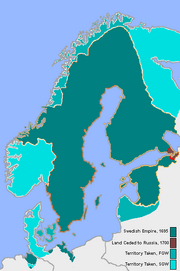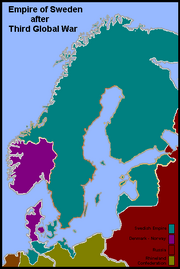Louisiannan (talk | contribs) (New page: {| border=1 align=right cellpadding=4 cellspacing=0 width=300 style="margin: 0 0 1em 1em; background: #f9f9f9; border: 1px #aaaaaa solid; border-collapse: collapse; font-size: 95%;" |+ '''...) |
m (I added flag again :^)) Tag: Visual edit |
||
| (22 intermediate revisions by 4 users not shown) | |||
| Line 11: | Line 11: | ||
|- |
|- |
||
|'''Currency''' || Swedish Krona |
|'''Currency''' || Swedish Krona |
||
| + | |- |
||
| + | |Flag |
||
| + | |[[File:Swedish Empire-0.png|thumb|220x220px]] |
||
|} |
|} |
||
| − | '''Sweden''', officially the '''Empire of Sweden''' (Swedish: Imperiet Sverige). It occupies the Scandinavian Peninsula in Northern Europe, surrounded by the Arctic Ocean and North Sea. Its capital city is Stockholm. |
+ | '''Sweden''', officially the '''Empire of Sweden''' (Swedish: ''Imperiet Sverige''). It occupies the Scandinavian Peninsula in Northern Europe, surrounded by the Arctic Ocean and North Sea. Its capital city is Stockholm. |
| + | ==The Great Northern War (POD)== |
||
| ⚫ | |||
| + | [[Image:TJ-imperietsverige.PNG|thumb|right|Growth of the Swedish Empire]] |
||
| − | [[Category:Toyotomi]] |
||
| + | Charles XII acceeded to entreaties of Poland-Lithuania in 1700 to broker a peace with Russia in the {{TJ|Great Northern War}}. Under advisement of Bengt Gabrielsson Oxenstierna, who had served as advisor on foreign affairs to his father Charles XI, the Treaty of Königsberg was signed, granting the Tsar of Russia navigation rights of the Neva river, and bringing an end to the Great Northern War. |
||
| + | |||
| + | Daughter wars would flare later in the century as a result of the poorly worded treaty, but were as quickly resolved, Charles XII and later his brother Ulrik I often known as the Arbiters of Europe. |
||
| + | |||
| + | ==Russian Alliance== |
||
| + | In 1702 Ulrik was married to HIH Natalia Petrovna, Grand Duchess of Russia. Natalia Petrovna was the second surviving child of Peter the Great and Eudoxia Lopukhina. With their marriage Sweden and Russia entered into a long period of ''detente''. |
||
| + | |||
| + | When Peter asked for Swedish help in conquest of Crimea, Charles XII was more than happy to oblige. During the course of the war Ulrik ruled as regent, and authorized the construction of the Russian exclave of Saint-Petersburg in Swedish Ingria, which was later granted as a Russian corridor territory to the Baltic. |
||
| + | |||
| + | Charles was critically wounded during the {{TJ|Russo-Krimean War}} (1701-1709), and while returning to Sweden in 1706 for extended convalescence succumbed to gangrene, and died as his ship left port in Saint-Petersburg. |
||
| + | |||
| + | With a carefully negotiated treaty King Ulrik I negotiated a long-standing right of way with Russia, allowing them access through the Baltic to the North Sea, provided they made no land grabs along the Baltic coast. The Treaty of Nystad lasted for all of Ulrik I's reign and into the reign of his son, Frederick-Adolph I. |
||
| + | |||
| + | ==First Global War== |
||
| + | |||
| + | Sweden sided with Russia and other pro-Japanese powers during the {{TJ|First Global War}}. While Sweden was not in actual alliance with Japan during the course of the war it had obtained right to all formerly Danish colonies. The Danish capital was moved to Århus as Sweden took possession of all islands in the straits between Sweden and Denmark, the Swedish Navy having virtually destroyed Copenhagen with bombardment. |
||
| + | |||
| + | Denmark and Norway had launched an assault on Sweden, Denmark attempting to secure the lost territories of Skåne, and Norway the land surrounding Trondheim. |
||
| + | |||
| + | ==Interbellum== |
||
| + | Frederick-Adolph I was married to Louisa Ulrika of Prussia, while his younger brother, Karl Gustavus was married to Anna Ioannovna, Empress of Russia. |
||
| + | |||
| + | ==Second Global War== |
||
| + | |||
| + | At the outset of the {{TJ|Second Global War}} Russia sold Karelia to Sweden to help fund their war efforts. Sweden obliged and maintained their offer of passage through the Baltic for Russian ships. |
||
| + | |||
| + | [[Image:TJ-TGWimperietsverige.PNG|thumb|right|Swedish Empire following the 3rd Global War]] |
||
| + | |||
| + | ==Third Global War== |
||
| + | Sweden dropped out of the {{TJ|Third Global War}} shortly after Russia, fighting civil war on two fronts in both Norway and Denmark. Peace was concluded after 5 years of civil strife and Denmark-Norway created during the peace process. |
||
| + | |||
| + | The Treaty of Nystad was broken during the Third Global War, and an uneasy detente fell on the Baltic, with looming treachery from Russia and confrontations over shipping rights with newly independent Denmark-Norway. These fears were mitigated with Helsingör (Helsingør) remaining in Swedish hands. |
||
| + | |||
| + | Ultimately,however, as a result of Sweden's neutrality with regard to the Franco-British conflict, she was rewarded with stewardship of [[Belgium (Toyotomi)|Belgium]]. |
||
| + | |||
| + | Sweden's navy also remained strong and successfully thwarted two attempted blockades. |
||
| + | {{TJnat|Sweden}} |
||
| ⚫ | |||
Latest revision as of 09:06, 11 October 2020
| Official Language | Swedish |
| Capital | Stockholm |
| King | ??? |
| Prime Minister | Fredrik Reinfeldt |
| Currency | Swedish Krona |
| Flag |  |
Sweden, officially the Empire of Sweden (Swedish: Imperiet Sverige). It occupies the Scandinavian Peninsula in Northern Europe, surrounded by the Arctic Ocean and North Sea. Its capital city is Stockholm.
The Great Northern War (POD)

Growth of the Swedish Empire
Charles XII acceeded to entreaties of Poland-Lithuania in 1700 to broker a peace with Russia in the Great Northern War. Under advisement of Bengt Gabrielsson Oxenstierna, who had served as advisor on foreign affairs to his father Charles XI, the Treaty of Königsberg was signed, granting the Tsar of Russia navigation rights of the Neva river, and bringing an end to the Great Northern War.
Daughter wars would flare later in the century as a result of the poorly worded treaty, but were as quickly resolved, Charles XII and later his brother Ulrik I often known as the Arbiters of Europe.
Russian Alliance
In 1702 Ulrik was married to HIH Natalia Petrovna, Grand Duchess of Russia. Natalia Petrovna was the second surviving child of Peter the Great and Eudoxia Lopukhina. With their marriage Sweden and Russia entered into a long period of detente.
When Peter asked for Swedish help in conquest of Crimea, Charles XII was more than happy to oblige. During the course of the war Ulrik ruled as regent, and authorized the construction of the Russian exclave of Saint-Petersburg in Swedish Ingria, which was later granted as a Russian corridor territory to the Baltic.
Charles was critically wounded during the Russo-Krimean War (1701-1709), and while returning to Sweden in 1706 for extended convalescence succumbed to gangrene, and died as his ship left port in Saint-Petersburg.
With a carefully negotiated treaty King Ulrik I negotiated a long-standing right of way with Russia, allowing them access through the Baltic to the North Sea, provided they made no land grabs along the Baltic coast. The Treaty of Nystad lasted for all of Ulrik I's reign and into the reign of his son, Frederick-Adolph I.
First Global War
Sweden sided with Russia and other pro-Japanese powers during the First Global War. While Sweden was not in actual alliance with Japan during the course of the war it had obtained right to all formerly Danish colonies. The Danish capital was moved to Århus as Sweden took possession of all islands in the straits between Sweden and Denmark, the Swedish Navy having virtually destroyed Copenhagen with bombardment.
Denmark and Norway had launched an assault on Sweden, Denmark attempting to secure the lost territories of Skåne, and Norway the land surrounding Trondheim.
Interbellum
Frederick-Adolph I was married to Louisa Ulrika of Prussia, while his younger brother, Karl Gustavus was married to Anna Ioannovna, Empress of Russia.
Second Global War
At the outset of the Second Global War Russia sold Karelia to Sweden to help fund their war efforts. Sweden obliged and maintained their offer of passage through the Baltic for Russian ships.

Swedish Empire following the 3rd Global War
Third Global War
Sweden dropped out of the Third Global War shortly after Russia, fighting civil war on two fronts in both Norway and Denmark. Peace was concluded after 5 years of civil strife and Denmark-Norway created during the peace process.
The Treaty of Nystad was broken during the Third Global War, and an uneasy detente fell on the Baltic, with looming treachery from Russia and confrontations over shipping rights with newly independent Denmark-Norway. These fears were mitigated with Helsingör (Helsingør) remaining in Swedish hands.
Ultimately,however, as a result of Sweden's neutrality with regard to the Franco-British conflict, she was rewarded with stewardship of Belgium.
Sweden's navy also remained strong and successfully thwarted two attempted blockades.
